The assumption is that same-day delivery costs are too expensive. In today’s tough economy, consumers are making decisions on where they can get the best value for their money. More consumers are demanding premium services at an affordable rate, but is it in fact feasible for a small business?
Is same-day delivery affordable for businesses?
The short answer is yes. But wait there is good news. There are ways to get around it. The answer lies in volume. If you are a small business, same-day delivery is not on your immediate to-do list. Same-day delivery can drive more revenue. You’ll never know until you try it.
Locate2u CEO Steve Orenstein and entrepreneur has first hand experience with this. “You need to try it for a decent amount of time, and make sure it’s advertised to your customers. Your overall cost of delivery might actually increase, but if you look at it from a total business point of view, you’re going to end up making more money. You’re gonna get more orders because more customers will have a great experience.”
How to make same-day delivery affordable
A survey done by Capgemini found 59% of the participants blamed high costs for their delivery dissatisfaction. According to the report, for same-day delivery last-mile costs from a store are 16% cheaper than delivery from a warehouse. But the majority of businesses have not yet done this, with the report indicating that only 8% of stores are equipped to deliver online orders.
Some businesses use dark stores for same-day deliveries which according to Capgemini could be 23% cheaper than conventional stores for same-day deliveries.
A dark store is a large retail facility that looks like a supermarket, but in fact it’s not open to the public. It only stocks products for online stores. It operates independently and is close to the delivery location.
According to the Capgemini report 29% of deliveries are fulfilled from dark stores. Their analysis shows that if deliveries from dark stores increased by 50%, profit margins could grow by 7% as a result of cheaper delivery costs and more deliveries.
Is same-day delivery during peak seasons affordable?
First question you need to ask yourself is: “Do I have enough capacity within my network?” If the answer is no, you need to urgently scale up. If you are still using spreadsheets and doing sortation of parcels based on postcodes or zip codes, you need to hand over the reins to technology. You’ll not only save time, but also money and keep your sanity.
As Orenstein explains, it’s not that complicated as some people may think: “You go into a business and they might have 20 drivers that are doing their deliveries, but actually they only need 18 or 15 drivers. Now if you take that cost and look at that over a year, that becomes a significant cost saving, by doing it really efficiently.”
Does a speedy same-day delivery compromise the quality?
As the old saying goes “time is money” but in this industry logistics is right up there too. From the moment the driver turns up at your store to grab the parcel as quickly as possible, to the point when the customer has the parcel in his/her hands. Time is of the essence. But you need to think from a drivers’ perspective. What will make it easier for the driver to find the parcel, scan and deliver it at a certain time?
As Orenstein puts it, it all comes down to speed: “Typically, these drivers have been paid on a per delivery basis. You want that driver to get in and out as quickly as possible to make it as efficient as possible. Also, if that driver is actually doing a large number of deliveries, you want them to be able to scan those parcels really quickly.”
About the author
Mia is a multi-award-winning journalist. She has more than 14 years of experience in mainstream media. She's covered many historic moments that happened in Africa and internationally. She has a strong focus on human interest stories, to bring her readers and viewers closer to the topics at hand.











